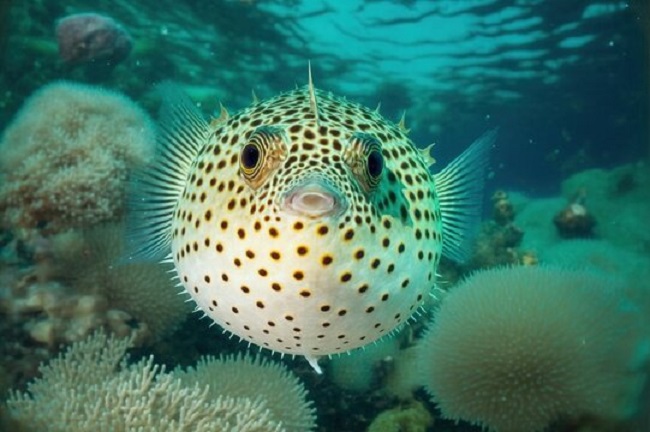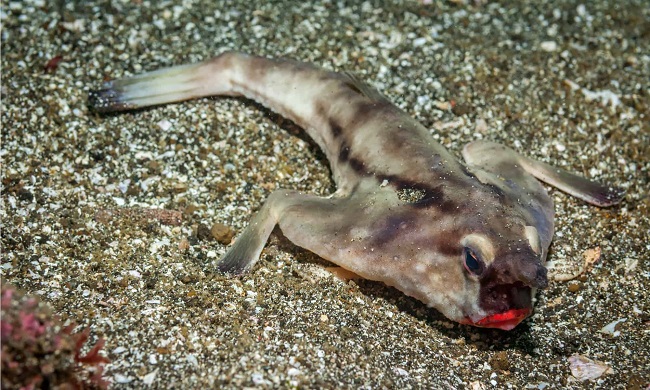While many fish are a nutritious and delicious part of the human diet, some species are either dangerous to consume or protected due to conservation efforts.
Here, we explore the top 40 types of fish that humans cannot eat, highlighting the reasons behind their inedibility or protection.
Exploring the Depths: Top 40 Types of Fish That Humans Cannot Eat
1. Pufferfish (Tetraodontidae)

Pufferfish, also known as fugu in Japan, is infamous for its toxicity. The fish contains tetrodotoxin, a potent neurotoxin that can be lethal if not prepared correctly. Due to the high risk, only specially trained and licensed chefs are allowed to prepare pufferfish in certain countries. For most people, consuming pufferfish is highly discouraged.
2. Stonefish (Synanceia)
The stonefish is one of the most venomous fish in the world, found in the coastal regions of the Indo-Pacific. Its venom can cause severe pain, paralysis, and even death. The stonefish’s spines deliver venom when stepped on or handled, making it extremely dangerous. Due to its toxicity, stonefish is not considered edible.
3. Lionfish (Pterois)
Lionfish are known for their striking appearance and venomous spines. Native to the Indo-Pacific, they have become invasive in the Atlantic and Caribbean. While lionfish meat is edible and considered a delicacy in some places, the risk of envenomation from their spines makes them dangerous to handle and consume without proper precautions.
4. Electric Eel (Electrophorus electricus)
The electric eel, native to the rivers of South America, can generate powerful electric shocks of up to 600 volts. These shocks are used for hunting and self-defense. While not poisonous, the risk of electric shock makes the electric eel dangerous and impractical to consume.
5. Goliath Tigerfish (Hydrocynus goliath)
The Goliath tigerfish, found in the Congo River Basin, is known for its ferocious nature and sharp teeth. It is a powerful predator that can pose a danger to humans. Due to its aggressive behavior and potential health risks, it is not considered a viable option for human consumption.
6. Giant Squid (Architeuthis)
While not a fish, the giant squid is often included in discussions about marine creatures. Found in deep ocean waters, these elusive creatures can grow to immense sizes. Their tough, rubbery flesh and the difficulty of capturing them make them impractical and unpalatable for human consumption.
7. Moray Eel (Muraenidae)
Moray eels are found in tropical and temperate seas worldwide. Some species contain ciguatoxin, which can cause ciguatera poisoning if consumed. Symptoms include nausea, vomiting, and neurological issues. The risk of poisoning and the eels’ aggressive behavior make them unsuitable for consumption.
8. Stargazer Fish (Uranoscopidae)
Stargazer fish are known for their unique appearance and venomous spines. Found in the Atlantic and Pacific Oceans, these fish can deliver electric shocks and venom. Due to the risk of envenomation and their unappetizing appearance, stargazer fish are not commonly eaten.
9. Blobfish (Psychrolutes marcidus)
The blobfish, found in deep waters off the coast of Australia and New Zealand, is known for its gelatinous appearance. While not poisonous, the blobfish’s unappealing texture and lack of culinary value make it inedible. It is also a deep-sea species, making it difficult to harvest.
10. Basking Shark (Cetorhinus maximus)
The basking shark, the second-largest fish in the world, is found in temperate oceans. It is a filter feeder, primarily consuming plankton. Basking sharks are protected in many areas due to their declining populations. Conservation efforts and their size make them unsuitable for human consumption.
11. Barracuda (Sphyraena)
Barracudas are known for their fearsome appearance and sharp teeth. While some species are edible, larger barracudas can accumulate ciguatoxins, which cause ciguatera poisoning. Symptoms include nausea, vomiting, and neurological issues. The risk of poisoning makes certain barracuda species unsuitable for consumption.
12. Surgeonfish (Acanthuridae)
Surgeonfish, named for the sharp spines near their tails, can carry ciguatoxins that cause ciguatera poisoning. Found in tropical oceans, these fish are brightly colored and often kept in aquariums. The risk of toxicity makes them unsuitable for human consumption.
13. Scorpionfish (Scorpaenidae)
Scorpionfish are known for their venomous spines that can deliver painful stings. Found in both temperate and tropical waters, these fish are well-camouflaged and often mistaken for rocks. The danger posed by their venomous spines makes them inedible for humans.
14. Anglerfish (Lophiiformes)
Anglerfish, found in deep-sea environments, are known for their bizarre appearance and bioluminescent lures. Their flesh is not considered toxic, but their deep-sea habitat makes them impractical to catch and consume. Additionally, their unattractive appearance and tough texture make them unappealing for culinary use.
15. Parrotfish (Scaridae)
Parrotfish are brightly colored reef fish known for their beak-like mouths used to scrape algae from coral. Some species of parrotfish can accumulate ciguatoxins, making them risky to eat. They also play a crucial role in maintaining healthy coral reefs, making them more valuable alive in their natural habitat.
16. Porcupinefish (Diodontidae)
Porcupinefish, related to pufferfish, are known for their ability to inflate their bodies and display sharp spines when threatened. These fish contain tetrodotoxin, the same potent neurotoxin found in pufferfish, making them extremely dangerous to consume.
17. Electric Ray (Torpediniformes)
Electric rays are capable of generating electric shocks to stun prey and defend themselves. Found in shallow waters of temperate and tropical seas, these rays are not poisonous, but their ability to deliver electric shocks makes them dangerous to handle and impractical to eat.
18. Oilfish (Ruvettus pretiosus)
Oilfish, also known as escolar, are deep-sea fish known for their high oil content. The oil, known as gempylotoxin, is indigestible and can cause gastrointestinal distress if consumed. Due to the unpleasant side effects, oilfish are generally considered inedible.
19. Guitarfish (Rhinobatidae)
Guitarfish, found in shallow coastal waters, are known for their guitar-shaped bodies. While not toxic, their flesh is tough and unpalatable. Additionally, many species of guitarfish are threatened or endangered, making them unsuitable for consumption due to conservation concerns.
20. Dogfish (Squalidae)
Dogfish are small sharks found in temperate and tropical waters. While some species are consumed in certain cultures, they contain high levels of urea and other compounds that can cause an unpleasant taste and odor. Additionally, overfishing has led to population declines in some species, making them less suitable for consumption.
21. Pilotfish (Naucrates ductor)

Pilotfish are small, striped fish often found swimming alongside sharks and other large marine animals. While not toxic, pilotfish are not typically consumed due to their association with larger predators and their small size, which offers little meat.
22. Triggerfish (Balistidae)
Triggerfish are known for their strong jaws and sharp teeth, used to crush shells of crustaceans and mollusks. Some species can carry ciguatoxins, causing ciguatera poisoning if consumed. Their aggressive nature and potential toxicity make them unsuitable for eating.
23. Cleaner Wrasse (Labroides)
Cleaner wrasses are small reef fish known for their role in cleaning parasites off larger fish. They are vital to the health of reef ecosystems. Their small size and ecological importance make them unsuitable for consumption.
24. Boxfish (Ostraciidae)
Boxfish, also known as cowfish or trunkfish, have a distinctive box-like shape. These fish can release toxins into the water when stressed, which can harm other marine life. Their toxicity and the difficulty in handling them make them inedible.
25. Mandarinfish (Synchiropus splendidus)
Mandarinfish are small, brightly colored fish found in the Pacific Ocean. They secrete a toxic mucus that deters predators. The toxicity and small size of mandarinfish make them unsuitable for human consumption.
26. Electric Catfish (Malapteruridae)
Electric catfish are found in freshwater rivers and lakes in Africa. They can generate electric shocks to stun prey and defend themselves. While not poisonous, the risk of electric shock makes them dangerous and impractical to eat.
27. Candiru (Vandellia cirrhosa)
Candiru, also known as the toothpick fish, are small parasitic catfish found in the Amazon River. They are infamous for their habit of entering the gills of larger fish (and sometimes the human body). Their parasitic nature and small size make them inedible and dangerous.
28. Titan Triggerfish (Balistoides viridescens)
The titan triggerfish is known for its aggressive behavior and powerful bite. Found in coral reefs, they can inflict serious injuries with their strong jaws. The potential for ciguatera poisoning and their aggressive nature make them unsuitable for eating.
29. Filefish (Monacanthidae)
Filefish are similar to triggerfish and are found in tropical and subtropical oceans. Some species can carry ciguatoxins, causing ciguatera poisoning if consumed. Their potential toxicity and often tough flesh make them unappealing for human consumption.
30. Horseshoe Crab (Limulidae)
While not a fish, the horseshoe crab is often included in discussions of marine creatures. Found in shallow coastal waters, their blood is valuable for medical research, but their tough exoskeleton and unappealing flesh make them unsuitable for eating. They are also important for the ecosystem, providing food for migratory birds.
31. Spiny Dogfish (Squalus acanthias)
The Spiny Dogfish, a small shark species, contains high levels of urea and ammonia, which can impart an unpleasant taste and odor to its flesh. While sometimes used in fish and chips, the potential for high toxin levels and overfishing concerns make them less desirable for consumption.
32. Venomous Catfish (Plotosidae)
Venomous catfish, found in freshwater and marine environments, possess venomous spines that can deliver painful stings. Species like the striped eel catfish have venom potent enough to cause severe pain and swelling. The risk of venom exposure makes these fish unsuitable for eating.
33. Napoleon Wrasse (Cheilinus undulatus)
The Napoleon Wrasse, also known as the Humphead Wrasse, is a large reef fish found in the Indo-Pacific region. Due to its overfished status and importance to coral reef ecosystems, it is protected under international conservation laws. Its conservation status makes it inedible.
34. Cownose Ray (Rhinoptera bonasus)
Cownose rays are found in the Atlantic Ocean and are known for their large, wing-like pectoral fins. They are not toxic, but their tough texture and cartilage-rich body make them unappetizing. Additionally, rays play a significant role in marine ecosystems, making them more valuable alive.
35. Fangtooth Fish (Anoplogaster cornuta)
The fangtooth fish, found in deep-sea environments, has an intimidating appearance with large teeth and a robust body. Its deep-sea habitat makes it difficult to catch, and its unappealing texture and taste make it impractical for consumption.
36. Gulper Eel (Eurypharynx pelecanoides)
The gulper eel is another deep-sea species known for its large mouth and long, slender body. Its deep-sea environment and gelatinous flesh make it inedible. Additionally, its unique biology makes it more of scientific interest than culinary.
37. Batfish (Ogcocephalidae)

Batfish are bottom-dwelling marine fish found in tropical and subtropical oceans. They have a unique body shape and rough texture. Their tough, unpalatable flesh and ecological role as bottom cleaners make them unsuitable for human consumption.
38. Parasitic Catfish (Trichomycteridae)
Parasitic catfish, also known as candiru, are small fish found in the Amazon Basin. Known for their parasitic behavior, they are infamous for entering the gills of larger fish. Their small size and parasitic nature make them unsuitable and unappealing for eating.
39. Leafy Seadragon (Phycodurus eques)
The leafy seadragon, found in the coastal waters of southern Australia, is a marine fish known for its elaborate leaf-like appendages. Protected due to their conservation status and ecological importance, they are not suitable for consumption.
40. Ribbon Eel (Rhinomuraena quaesita)
Ribbon eels, found in the Indo-Pacific region, are known for their vibrant colors and elongated bodies. Their delicate nature and specific habitat requirements make them unsuitable for human consumption. Additionally, they are often protected to preserve their populations.
Conclusion
These top 40 types of fish highlight the diversity of marine life that is not suitable for human consumption, whether due to toxicity, danger, or conservation status.
Understanding these species helps raise awareness about the importance of marine conservation and the need to respect and protect our oceans’ biodiversity.
By recognizing the reasons behind their inedibility, we can better appreciate the complex and fascinating world of marine life.



